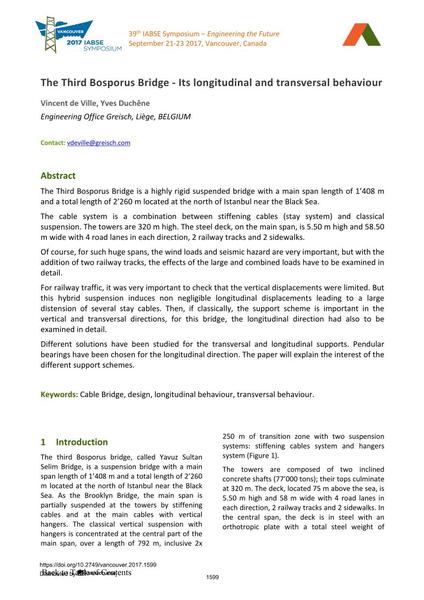The Third Bosporus Bridge - Its longitudinal and transversal behaviour

|
|
|||||||||||
Bibliographic Details
| Author(s): |
Vincent De Ville
(Engineering Office Greisch, Liège, BELGIUM)
Yves Duchêne (Engineering Office Greisch, Liège, BELGIUM) |
||||
|---|---|---|---|---|---|
| Medium: | conference paper | ||||
| Language(s): | English | ||||
| Conference: | IABSE Symposium: Engineering the Future, Vancouver, Canada, 21-23 September 2017 | ||||
| Published in: | IABSE Symposium Vancouver 2017 | ||||
|
|||||
| Page(s): | 1599-1606 | ||||
| Total no. of pages: | 8 | ||||
| Year: | 2017 | ||||
| DOI: | 10.2749/vancouver.2017.1599 | ||||
| Abstract: |
The Third Bosporus Bridge is a highly rigid suspended bridge with a main span length of 1’408 m and a total length of 2’260 m located at the north of Istanbul near the Black Sea. The cable system is a combination between stiffening cables (stay system) and classical suspension. The towers are 320 m high. The steel deck, on the main span, is 5.50 m high and 58.50 m wide with 4 road lanes in each direction, 2 railway tracks and 2 sidewalks. Of course, for such huge spans, the wind loads and seismic hazard are very important, but with the addition of two railway tracks, the effects of the large and combined loads have to be examined in detail. For railway traffic, it was very important to check that the vertical displacements were limited. But this hybrid suspension induces non negligible longitudinal displacements leading to a large distension of several stay cables. Then, if classically, the support scheme is important in the vertical and transversal directions, for this bridge, the longitudinal direction had also to be examined in detail. Different solutions have been studied for the transversal and longitudinal supports. Pendular bearings have been chosen for the longitudinal direction. The paper will explain the interest of the different support schemes. |
||||
| Keywords: |
design cable bridge longitudinal behaviour transversal behaviour
|
||||
